Abstract
Simultaneous wireless information and power transfer (SWIPT) has been utilized widely in wireless sensor networks (WSNs) to design systems that can be sustained by harvesting energy from the surrounding areas. In this study, we investigated the performance of the low-power energy harvesting (LPEH) WSN. We equipped each relay with a battery that consisted of an on/off (1/0) decision scheme according to the Markov property. In this context, an optimal loop interference relay selection was proposed and investigated. Moreover, the crucial role of the log-normal distribution method in characterizing the LPEH WSN’s constraints was proven and emphasized. System performance was evaluated in terms of the overall ergodic outage probability (OP) both analytically and numerically with Monte Carlo simulation. The system had the lowest overall ergodic OP, thus, performed the best with an energy harvesting time switch of 0.175. Following the increase in the signal-to-noise ratio (SNR), the system without a direct link performed the worst. Furthermore, as more relays were deployed, the better the system performed. Finally, results showed that more than 80% of the data rates can be obtained under the household condition, without the need for extra bandwidth and power supply.
1. Introduction
Following the advancement of the fifth and upcoming sixth generation communication, simultaneous wireless information and power transfer (SWIPT) holds its place as a promising technology for self-sustaining communication systems. In particular, it can offer notable system performance gains, indicated by improvements in spectral efficiency (SE), power consumption, interference management, and transmission delay, due to its nature of facilitating simultaneous information and energy transmission [1,2,3]. For the SWIPT cooperative relaying system, there are two major modes in use: the half-duplex (HD) and the full-duplex (FD). Specifically, in HD mode, the relay is equipped with one antenna that functions so that data retransmission from the source is carried out on dedicated and orthogonal channels [4]. Meanwhile, in FD mode, a relay is equipped with two antennas to facilitate data reception and transmission in the same time frame and bandwidth. Moreover, it is worth noting that the FD wireless network is praised for its ability to double the SE, considerably improving the network throughput in comparison with the HD network.
The combination of the FD operating mode in EH relaying networks has been a debatable topic regarding the possibility of sustainability when operating FD mode and performing the relaying task. However, with the advancement of the antenna, battery technologies, and signal processing capacity, it is reasonable to re-assess the FD-EH relaying networks for the promising benefits they can offer, as in [5,6,7]. Additionally, in [8] Li et al. showed that the utilization of energy storage can bring in zero diversity gain when the signal-to-noise ratio (SNR) level is high. Remarkably, Zhong et al. in [5] extensively discussed the constraints of FD-EH relaying networks and proved that system performance in three different transmission modes can be significantly enhanced.
To describe the outdoor wireless channel, Rayleigh, Rician, and Nakagami-m fading channels have been widely accepted among network designers [9]. However, for indoor settings, due to the shadowing effects caused by walls, obstructions, and human movements, log-normal is a better choice [10,11,12,13]. Thus, log-normal is a more suitable candidate for smart homes and industrial Internet of Things (IIoTs) applications. In addition, it is reasonable to use the current advancement in the relaying network technology to further boost the system performance of the household networks. In fact, this has been proven to provide higher channel capacity, a wider network coverage range, and a lesser shadowing effect [11]. Moreover, equipping more relays in a cooperative relaying system provides a greater degree of freedom (DoF), enabling the system to combine more independent fading signals from several relays in operation, hence resulting in higher system performance [14]. The above studies have provided a background to develop a low-power energy harvesting (LPEH) wireless sensor network (WSN), which can counteract the high signal attenuation and noise in household environments [15,16,17].
Although the energy harvested from radio frequency (RF) is relatively low in comparison to other sources such as thermal, solar, etc., it is sufficient to operate several devices and sensors as noted by Assogba et al. [18]. Specifically, authors in [19] attempted to measure the free ambient RF and found that by densifying the Wi-Fi access points, it is possible to not only power the indoor devices (smoke detectors, wearable electronics, etc.) but to also extend their lifetime via trickle charging. Furthermore, in regard to upgrading indoor electrical grids, a Power Line Communication (PLC) has been investigated; wireless devices can exploit the existing electricity cables to improve data transmission and energy efficiency [20]. PLC enables establishing communication with remote or highly attenuated nodes that are underground, in buildings with metal walls, obstructed, or in hospitals where the electromagnetic interference is not allowed. In addition, PLC can work as either a standalone system or as a facilitator of Wi-Fi extension in a large in-house environment [21]. In the past, PLC operated in narrowband with a range of 3–500 kHz and a low data rate, which is undesirable for modern demands. Thus, Ref. [22] has investigated the possibilities of deploying broadband PLC with the range of 1.8–2.5 MHz and a high data rate to serve multimedia services in household environments. Several PLC standards have been developed [23,24,25]. Application wise, PLC has constituted to the smart grid (SG), which is the foundation for smart city applications including traffic and lighting control [26,27], lighting systems in urban areas [28], irrigation, and other smart city applications. [29].
Regarding the security of the physical layer, the available techniques for wireless networks are applicable for PLC as well. For example, a case study of how to utilize the jamming technique to guard against eavesdroppers for cooperative PLC networks was presented in [30]. In the household setup, it is highly recommended to utilize log-normal fading channels because other fading channels cannot describe efficiently the fading effects caused by walls, human movement, and indoor obstructions [31]. Several papers have extensively analyzed the performance of relay-aided EH wireless networks embedded in the PLC using different key parameters. Research has proven this combination is promising for the future of smart grids and indoor wireless communication [32,33,34,35,36], which is undeniably powered by the development of LPEH WSN.
As can be concluded from the reviewed literature, WSN cannot perform well in indoor environments due to the extensive shadowing effect caused by indoor obstructions. To create an efficient communication system for indoor setups, it is of great interest to deploy the WSN together with PLC and EH modules. However, the effect of the interactions between the three technologies on system performance has not been well studied in the existing literature. Therefore, in this manuscript, we assess the performance of a relay selection (RS) scheme, the optimal loop interference RS scheme in the context of LPEH WSN. Notably, the relays are equipped with batteries and operate with the FD-AF protocol. The shadowing effect of the network is characterized by log-normal fading channels.
2. System Models
Figure 1 below depicts an LPEH WSN that includes a source (S), an in-between cluster (C) of K cooperative relays , and a destination (D). As investigated in [37,38], this setup is typical and appropriate for studying the impact of RS schemes operating in wireless networks. Additionally, the coverage extension scenario is assumed so that communication between (S) and (D) can be achieved only with the help of the intermediate relays [39,40]. Moreover, the solution can help overcome the deep shadowing effects caused by the movement of humans or obstacles in the surrounding area, making it more suitable for the studied LPEH WSN, [37].
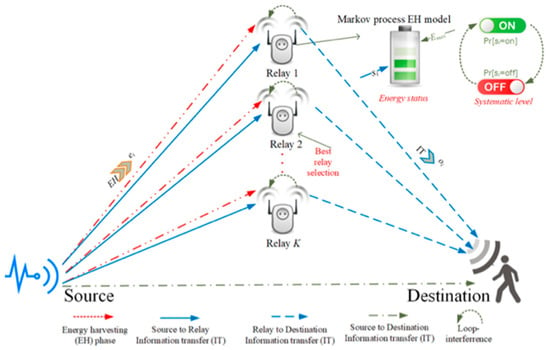
Figure 1.
System models.
In addition, the carrier and symbol synchronization are assumed to be ideal. Each terminal knows beforehand its own channel state information (CSI). (S) is powered by a stable power source and every (R) is powered by a battery together with an EH module. The additive white Gaussian noise (AWGN), , is with zero mean and variance at the and (D), respectively.
In fact, the distances from (S) to to (D), and (S) to (D) are denoted with and . Their corresponding channel coefficients are , , and . As in Laourine et al. [10] and Mellios et al. [41], (S) and (D) are HD and (R)s are FD. The FD setup causes the loop interference channel to the system. During the communication, which is split into time slots, the -th relay is selected as per a (RS) scheme to help establishing the information transmission. Within a signal block, the narrowband transmits signals at (S) and is denoted as , , and has zero mean. The statistical mean operation is denoted with .
We consider random variables (RVs) that are independently and identically distributed (i.i.d) as per log-normal distribution as , , and . The RVs are associated with parameters , , and , respectively. Furthermore, the i.i.d loop interference channel following log-normal distribution is with parameter . The loop interference strength given by this parameter is important to characterize the performance of the FD system.
2.1. Standalone Direct Link
To serve as a foundation for further study, a direct transmission protocol, in which (S) transmits information directly to (D) without any assisting (R) in the LPEH WSNs is assumed and investigated.
Definition 1.
In the context of the direct transmission protocol, the direct (S)-(D) link is the unique option. Thus, it will use all the time slots in the signal block for data transmission.
As in [42], we employ a block fading channel assuming that the service process is stationary, and that the buffer receives data at a constant rate. From the analytical point of view, the effective capacity after normalization is the same as the conventional Shannon ergodic capacity under the condition of no delay constraint.
Thus, employing the direct transmission protocol, the overall (S)-(D) capacity can be obtained with zero mean, circularly symmetric
where is the path loss exponent, and is the frequency bandwidth.
As mentioned above, the ergodic OP is an indicator for evaluations of system performance. This is the probability that instantaneous capacity falls below a given threshold’s bits per channel use (BPCU) being , and . Here, the probability density function (PDF) and the cumulative distribution function (CDF) of the RV in log-normal distribution [43] are, respectively, calculated by
and
where is the Gaussian .
By utilizing the CDF of the log-normally distributed RV in (1), the ergodic OP for the direct transmission protocol can be expressed as
where is a scaling constant [44],
Remark 1.
The direct link of the relay-aided systems offers better data rate gain in noisier condition, that is, when the SINR and data rates are low. It is also worth noting that relay-aided links are highly beneficial for transmission over long distance. In normal conditions, the direct link is sufficient to establish a successful communication.
2.2. Relay-Aided Cooperative Protocol
As previously mentioned, the relay-aided cooperative protocol is deployed to improve the LPEH WSN performance.
Definition 2.
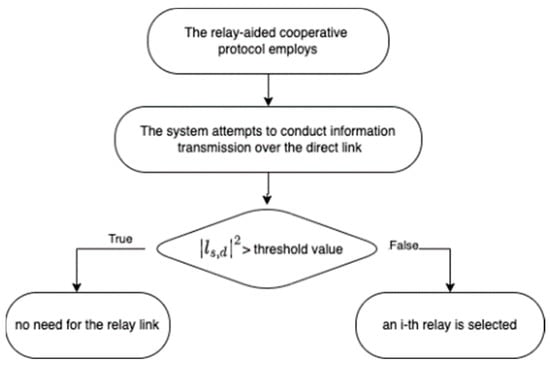
In the context of the relay-aided cooperative protocol, all relay links can alternatively transmit the data in place of the direct link. Specifically, if the direct link is severely attenuated, a relay will be chosen among from the cluster (C) to realize the data transmission alternatively. This is performed on a condition that the relay has a sufficient amount of energy to conduct the task. This process is shown below in Figure 2.

Figure 2.
Criteria for relay selection.
By this approach, more time slots are saved, and overhead information is reduced, because only the needed relay link is activated. Moreover, in LPEH WSN, we can receive the maximal diversity gain equaling the relay nodes that are available in the network, as proven in [4].
As described in [39], one transmission cycle from (S) to (D) realized within time is split into three slots as per the TSR protocol. The first time slot , where is the EH time factor, , is spent by (R) to harvest the energy from the signal that (S) broadcasts. The remaining is halved with one half for information of and the other for
Within , given the energy harvested the -th (R) has harvested, , the power that the relay transmits can be described as
where the EH efficiency , , shows the circuitry’s characteristics.
As mentioned in [5] as a relay can recognize its own signal in the FD multi-relay scenario, the interference cancellation can be applied to itself.
For , the signal after the interference cancellation at the -th (R) can be expressed as
where the information signal is normalized as . The imperfect interference cancelation leaves out the residual loop interference and
In an FD-AF system, after the signal is base-band processed at as per (6), it is amplified and then sent to (D). Therefore, (D) receives the signal of
where the relay gain, , denotes the instantaneous received power normalization, within which process the relay transmission is allowed with maximum power, , according to [45,46]
Then, (8) is substituted into (7) and modified so that the end-to-end SNR of the -th (R) at (D) can be obtained
where and
Additionally, the instantaneous capacity of the FD-AF-TSR system can be calculated
From this, the RS scheme for the in-studied LPEH WSN optimal loop interference relay selection scheme is derived. In particular, the RS scheme first chooses (R) having the best end-to-end link, then updates the SINR in the first branch. Thus, the selected relay, with , has the condition of
It should be noted that the optimal loop interference RS scheme is established only if the full CSI is known.
2.3. Energy Storage Modeling at Relay
The stationary stochastic process in Tutuncuoglu et al. [46], states that the minimum energy needed to activate and the harvested energy within the -th signal block as Firstly, the is assumed without energy storage, thus, operates only with . The runs out of energy if . The probability that this event occurs is named energy-exhausted probability and can be formulated as follows.
where is used to signify the PDF of the stationary stochastic process
In practice, however, the is installed with a battery with the capacity of . The -th signal block transmission consumes an amount of energy. As per the condition in Definition 2, the can be expressed with the stationary random function as
where denotes that every can be activated with an equal probability. Notably, the variables and are stationary and independent.
Additionally, to formulate the energy buffer status according to the Markov stochastic process, we use the denotation , which stands for the initial energy amount the stores before starting the -th signal block transmission.
Subsequently, we can combine (12), (13), and the original PDF of to obtain the stationary PDF of being . Theoretically, all the stochastic characteristics of the EH module can be described with . However, because it is not necessary to include all these energy buffer statuses in the system described here, a simplified model is proposed. Specifically, according to Definition 2, the number of statuses is reduced to two processing steps and described in Lemma 1.
Lemma 1.
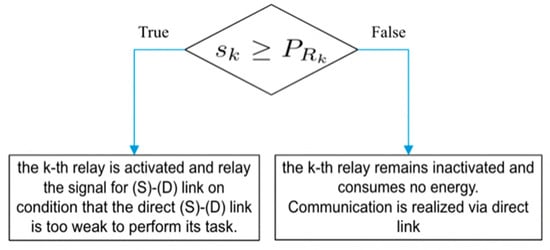
The and the possible energy that can be consumed at are compared to make the decision on whether the transmission should be realized on the direct or the relaying link. This is shown below in Figure 3.

Figure 3.
Criteria for choosing the direct or relaying link for information transmission.
These two statuses are therefore used to characterize the flow of the energy that has been harvested. Accordingly, we proposed an on–off model with denotation , which is described in Figure 1. Then, we used the stationary PDF of , to formulate the stationary PDF of as follows.
Remarkably, (14) is not the same as the original PDF of the harvested energy in (13).
Subsequently, an on–off (on/off status) model to describe the harvested energy flow has been formulated and described in the following Remark 2. For more details on the derivation, see [47].
Remark 2.
The relaying link in LPEH WSN can be activated if the direct link cannot perform the information transmission task and the available energy stored at the relay is greater than . Additionally, thanks to the two parameters and , which characterize the EH module employed in , we can capture the stochastic property of the energy harvested beforehand with no loss.
3. Performance Analysis
3.1. Formulating the Problem
In practice, the relaying link over cannot always be established due to deep fading or energy exhausting when the surrounding energy resources fluctuate. This event is named an overall outage event and can be caused by three reasons as follows.
At least one of the data packets cannot be successfully delivered during the information transmission from (S) to (D). This causes the direct link’s end-to-end SNR to be below the threshold value of the system.
The energy harvested by is not sufficient, so it cannot be activated to realize the information transmission via the relaying link. This is known as energy-exhausted probability.
The relay is activated but cannot transfer all the data packets successfully with a sufficient amount of energy from the EH process. This also causes the relaying link’s end-to-end SNR to be below the threshold value of the system.
Having acknowledged the above constraints, for the herein study, we assume that possesses a sufficient amount of energy to realize the information transmission. Subsequently, the overall ergodic OP of the FD-AF-TSR LPEH WSN described in Definition 2 can be formulated as follows
3.2. Analysis of the Probability of Overall Ergodic Outage
With regard to (10), the ergodic OP for S––D link can be fully defined as
where .
Proposition 1.
The SNR in (11) is assumed to be high and identical. Thus, we can formulate the corresponding overall ergodic OP for the high SNR range under the RS scheme as
where,
Proof of Proposition 1.
It is worth noting that the in (11) is crucial for the RS process. As we combine (5) and (6), we can formulate the SNR at (R) as follows
Similarly, the SNR at (D) is given by
Subsequently, we combine (18) and (19), then substitute them into (11) to obtain the ergodic OP in (16), considering , as follows
where and .
It should be noted that all the aforementioned channel means and variances are i.i.d. as per the log–normal distribution. Assuming that and are two independent RVs, the ergodic OP of the system with the optimal RS scheme in (11) can be expressed as
where and are the complementary CDFs of and . Because RV is distributed in a log–normal manner, its complementary CDF can be obtained with ease as follows:
Moreover, the RV is a product of two RVs which are as well log–normally distributed, its complementary CDF can be obtained as
As we substitute (22) and (23) into (21), the ergodic OP can be obtained as
Consequently, (24) and (4) are substituted into (15) to obtain the overall ergodic OP in the optimal RS scheme, as given in (17). □
4. Results and Discussion
In this section, the Monte Carlo numerical simulation was conducted to investigate the overall ergodic OP of the in-studied system with an optimal RS scheme. In summary, the analytic results were obtained by evaluating the log–normal distribution following [45]. The system parameters for the simulations are listed below in Table 1. The results are calculated based on Proposition 1 in (17), by means of MatLab simulation.

Table 1.
Simulation parameters.
Figure 4 illustrates the overall ergodic OP versus the EH time switch . Two values of loop interference channel variance being and 4 (dB) are used together with the constant power source of (dB). It is possible to observe that the two curves reach their minimum at , at which the system performs the best and the coding gap is the largest. As increases to more than 0.3, the overall ergodic OP curves exponentially decrease, corresponding to the extreme case where too much time is dedicated to EH activity, resulting in insufficient time for data transmission purpose. The principle for this behavior is that, starting from 0, when we increase the power source, the message from the source has higher probability to be successfully decoded, leading to a more successful DF process. Nevertheless, when the power source passes the threshold value, the probability that the relay can decode the message from the source is so high that it reduces the relay power and the quality of the second hop. Therefore, the existence of an optimal must be considered when designing such a network.
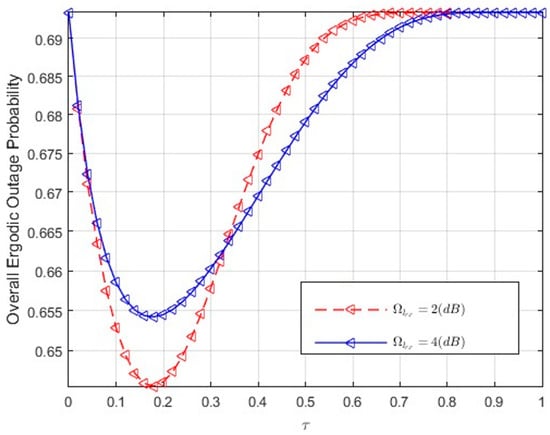
Figure 4.
Relation between the overall ergodic OP and the EH time switch , with two values.
Figure 5 shows the relation between the overall ergodic OP of the LPEH WSN and the SNR. For comparison, we use three values of 0, 0.5, and 1 for the energy-exhausted probability of best RS. The when the LPEH WSN operates with the cooperative relays, with direct link, and for both or only the relay link (red color). It can be noted that as SNR increases from −20 to 30 dB, the without a direct link delivers the highest overall ergodic OP, thus, the worst system performs. The remaining curves are relatively closed to each other and sharply approach 0 overall ergodic OP when the SNR increases to 30 (dB). Theory and simulation agree well with each other and suggest the importance of implementing the EH cooperative relays in boosting the performance of the LPEH WSN. Additionally, it is remarkable that the data rate has been significantly improved, with over 80% data rates achieved under the PLC condition, requiring no extra bandwidth or power supply.
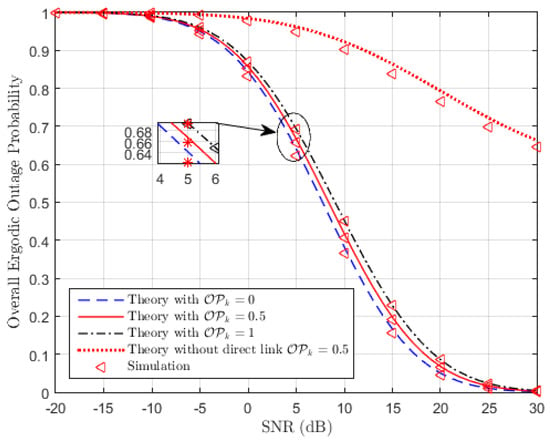
Figure 5.
Relation between the overall ergodic OP and the SNR, with three values.
Figure 6 plots the overall ergodic OP versus the SNR when changing the number of relays, , from 1 to 3 and 5. The three curves are simulated with . It is quite intuitive that the more intermediate relays are installed, the lower the overall ergodic OP curve, leading to better system performance. Remarkably, changing the number of relays results in performance curves with similar shapes as changing the value. So far, it can be concluded that the utilization of intermediate EH relays is beneficial for LPEH WSNs with the best RS, and the higher the number of relays, the better the system performs.
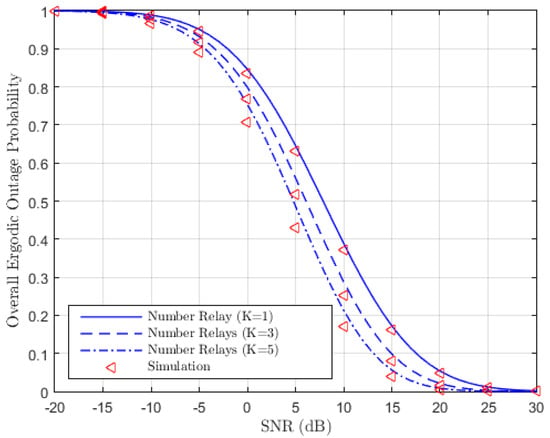
Figure 6.
Relation between the overall ergodic OP and the SNR, with three values.
Using log–normal fading channels to characterize the shadowing effects, the herein system can characterize real indoor scenarios. However, being too specific in LPEH WSN means that it is hard for the proposed model to be scaled up without the expertise for both software and hardware and how to implement them together. Moreover, since the studies on the smart grid are just in their early stages, in-depth help is not easily accessible in the existing literature. Other shortcomings of the model are mentioned in the next section as we discuss possible future research to improve the model in question.
5. Conclusions
In general, the paper presents the performance analysis in terms of the overall ergodic OP of the optimal RS scheme in the context of LPEH WSN. Since the simulations correlate well with the theory, the expressions that we derived show potential to be applicable for future studies. It is also proven that the log–normal fading channel is appropriate for modelling such indoor scenarios. Future studies, which would complement the shortcomings of this study, can consider different RS schemes and compare them with the studies in this paper to find the best one for the LPEH WSN setup. In addition, experimental studies can be conducted to compare the results in this study with reality. With regard to eco-friendly networks, in the next studies, we can compare the technical requirements for the coexistence of PLC systems and other communication technologies. We can evaluate how the resource should be allocated in a system with a multicarrier and improve the signal processing and channel coding abilities of the system. Furthermore, we can compare the protocols that are used for LPEH WSN with other protocols that have been utilized for WSN and the dynamics of the physical layers to facilitate further implementation of PLC in the near future.
Author Contributions
Conceptualization, H.-S.N. and H.-P.V.; methodology, formal analysis, H.-P.V. and L.S.; writing—original draft preparation, L.S.; writing—review and editing, H.-P.V. and H.-S.N.; visualization, H.-S.N.; supervision, H.-S.N. All authors have read and agreed to the published version of the manuscript.
Funding
This work has been supported by the Slovak Scientific Grant Agency (VEGA), Project No. 1/0588/22 “Research of a location-aware system for achievement of QoE in 5G and B5G networks” and under the project of Operational Programme Integrated Infrastructure: Independent research and development of technological kits based on wearable electronics products, as tools for raising hygienic standards in a society exposed to the virus causing the COVID-19 disease, ITMS2014+ code 313011ASK8. The project is co-funded by the European Regional Development Fund. This research is also funded by Thu Dau Mot University under grant number DT.20.2-020.
Data Availability Statement
The data presented in this study are available on request from the corresponding author.
Conflicts of Interest
The authors declare no conflict of interest.
References
- Perera, T.D.P.; Jayakody, D.N.K.; Sharma, S.K.; Chatzinotas, S.; Li, J. Simultaneous wireless information and power transfer (SWIPT): Recent advances and future challenges. IEEE Commun. Surv. Tutor. 2018, 20, 264–302. [Google Scholar] [CrossRef] [Green Version]
- Sidhu, R.K.; Ubhi, J.S.; Aggarwal, A. A survey study of different RF energy sources for RF energy harvesting. In Proceedings of the 2019 IEEE International Conference on Automation, Computational and Technology Management (ICACTM), London, UK, 24–26 April 2019. [Google Scholar] [CrossRef]
- Nguyen, H.-S.; Ly, T.; Nguyen, T.-S.; Huynh, V.; Nguyen, T.-L.; Voznak, M. Outage performance analysis and SWIPT optimization in energy harvesting wireless sensor network deploying NOMA. Sensors 2019, 19, 613. [Google Scholar] [CrossRef] [Green Version]
- Laneman, J.; Tse, D.; Wornell, G. Cooperative diversity in wireless networks: Efficient protocols and outage behavior. IEEE Trans. Inf. Theory 2004, 50, 3062–3080. [Google Scholar] [CrossRef]
- Zhong, C.; Suraweera, H.A.; Zheng, G.; Krikidis, I.; Zhang, Z. Wireless information and power transfer with full duplex relaying. IEEE Trans. Commun. 2014, 62, 3447–3461. [Google Scholar] [CrossRef] [Green Version]
- Liu, H.; Kim, K.J.; Kwak, K.S.; Poor, H.V. Power splitting-based SWIPT with decode-and-forward full-duplex relaying. IEEE Trans. Wirel. Commun. 2016, 15, 7561–7577. [Google Scholar] [CrossRef]
- Zeng, Y.; Zhang, R. Full-duplex wireless-powered relay with self-energy recycling. IEEE Wirel. Commun. Lett. 2015, 4, 201–204. [Google Scholar] [CrossRef] [Green Version]
- Li, T.; Fan, P.; Letaief, K.B. Outage probability of energy harvesting relay-aided cooperative networks over rayleigh fading channel. IEEE Trans. Veh. Technol. 2016, 65, 972–978. [Google Scholar] [CrossRef] [Green Version]
- Zhang, Z.; Chai, X.; Long, K.; Vasilakos, A.V.; Hanzo, L. Full duplex techniques for 5g networks: Self-interference cancellation, protocol design, and relay selection. IEEE Commun. Mag. 2015, 53, 128–137. [Google Scholar] [CrossRef] [Green Version]
- Laourine, A.; Stephenne, A.; Affes, S. Estimating the ergodic capacity of log-normal channels. IEEE Commun. Lett. 2007, 11, 568–570. [Google Scholar] [CrossRef]
- Zhang, Z.; Zhang, W.; Tellambura, C. Cooperative OFDM channel estimation in the presence of frequency offsets. IEEE Trans. Veh. Technol. 2009, 58, 3447–3459. [Google Scholar] [CrossRef] [Green Version]
- Di Renzo, M.; Graziosi, F.; Santucci, F. Performance of Cooperative Multi-Hop Wireless Systems over Log-Normal Fading Channels. In Proceedings of the IEEE GLOBECOM 2008—2008 IEEE Global Telecommunications Conference, New Orleans, LA, USA, 2008; pp. 1–6. [Google Scholar] [CrossRef]
- Zhu, B.; Cheng, J.; Yan, J.; Wang, J.; Wu, L.; Wang, Y. A new technique for analyzing asymptotic outage performance of diversity over lognormal fading channels. In Proceedings of the IEEE 2017 15th Canadian Workshop on Information Theory (CWIT), Quebec City, QC, Canada, 11–14 June 2017. [Google Scholar] [CrossRef]
- Foschini, G.J. Layered space-time architecture for wireless communication in a fading environment when using multi-element antennas. Bell Labs Tech. J. 2002, 1, 41–59. [Google Scholar] [CrossRef]
- Rubin, I.; Lin, Y.-Y.; Kofman, D. Relay-aided networking for power line communications. In Proceedings of the IEEE Information Theory and Applications Workshop (ITA), San Diego, CA, USA, 9–14 February 2014. [Google Scholar] [CrossRef]
- Rabie, K.M.; Adebisi, B.; Yousif, E.H.G.; Gacanin, H.; Tonello, A.M. A comparison between orthogonal and non-orthogonal multiple access in cooperative relaying power line communication systems. IEEE Access 2017, 5, 10118–10129. [Google Scholar] [CrossRef]
- Pu, H.; Liu, X.; Zhang, S.; Xu, D. Adaptive cooperative non-orthogonal multiple access-based power line communication. IEEE Access 2019, 7, 73856–73869. [Google Scholar] [CrossRef]
- Assogba, O.; Mbodji, A.K.; Diallo, A.K. Efficiency in RF energy harvesting systems: A comprehensive review. In Proceedings of the IEEE International Conference on Natural and Engineering Sciences for Sahel’s Sustainable Development Impact of Big Data Application on Society and Environment (IBASE-BF), Ouagadougou, Burkina Faso, 4–6 February 2020. [Google Scholar] [CrossRef]
- Georgiou, O.; Mimis, K.; Halls, D.; Thompson, W.H.; Gibbins, D. How many wi-fi aps does it take to light a lightbulb? IEEE Access 2016, 4, 3732–3746. [Google Scholar] [CrossRef]
- Wu, X. Reliable Indoor Power Line Communication Systems: Via Application of Advanced Relaying Processing. Ph.D. Thesis, Curtin University, Perth, Australia, 5 November 2016. [Google Scholar]
- Galli, S.; Latchman, H.; Oksman, V.; Prasad, G.; Yonge, L. Multimedia PLC systems. In Power Line Communications: Principles, Standards and Applications from Multimedia to Smart Grid; John Wiley and Sons: Hoboken, NJ, USA, 2016; pp. 473–508. [Google Scholar] [CrossRef]
- Berger, L.T.; Schwager, A.; Pagani, P.; Schneider, D.M. MIMO power line communications. IEEE Commun. Surv. Tutor. 2015, 17, 106–124. [Google Scholar] [CrossRef]
- Ben-Yehezkel, Y.; Gazit, R.; Haidine, A. Performance evaluation of medium access control mechanisms in high-speed narrowband PLC for smart grid applications. In Proceedings of the IEEE International Symposium on Power Line Communications and Its Applications (ISPLC), Beijing, China, 27–30 March 2012; pp. 94–101. [Google Scholar] [CrossRef]
- IEEE Standard for Broadband over Power Line Networks: Medium Access Control and Physical Layer Specifications; IEEE Std 1901-2020 (Revision of IEEE Std 1901-2010); IEEE: Piscataway, NJ, USA, 2021; pp. 1–1622. [CrossRef]
- HomePlug Green PHY Specification Release Version 1.1, HomePlug Alliance Standard, January 2012. Available online: http://www.homeplug.org/tech/whitepapers/HomePlug_Green_PHY_whitepaper_121003.pdf (accessed on 1 March 2020).
- Calderoni, L.; Maio, D.; Rovis, S. Deploying a network of smart cameras for traffic monitoring on a ‘city kernel. Expert Syst. Appl. 2014, 41, 502–507. [Google Scholar] [CrossRef]
- Martínez-Rodríguez-Osorio, R.; Calvo-Ramon, M.; Fernández-Otero, M.Á.; Navarrete, L.C. Smart control system for LEDs traffic-lights based on PLC. In Proceedings of the 6th WSEAS International Conference on Power Systems, Lisbon, Portugal, 22–24 September 2006; pp. 256–260. [Google Scholar]
- Lighting PLC Applications. Available online: https://www.smart-energy.com/regional-news/europe-uk/street-lighting-problems-and-solutions/ (accessed on 1 March 2020).
- Litra, G. The Smart City Opportunity for Utilities; Technical Reports; Scottmadden Management Consultants: Atlanta, GA, USA, 2017; Available online: https://www.scottmadden.com/insight/the-smart-city-opportunity-for-utilities/ (accessed on 1 January 2020).
- Salem, A.; Hamdi, K.A.; Alsusa, E. Physical layer security over correlated log-normal cooperative power line communication channels. IEEE Access 2017, 5, 13909–13921. [Google Scholar] [CrossRef]
- Renzo, M.D.; Graziosi, F.; Santucci, F. A comprehensive framework for performance analysis of cooperative multi-hop wireless systems over log-normal fading channels. IEEE Trans. Commun. 2010, 58, 531–544. [Google Scholar] [CrossRef] [Green Version]
- Cheng, X.; Cao, R.; Yang, L. Relay-aided amplify-and-forward powerline communications. IEEE Trans. Smart Grid 2013, 4, 265–272. [Google Scholar] [CrossRef]
- Ezzine, S.; Abdelkefi, F.; Cances, J.P.; Meghdadi, V.; Bouallegue, A. Evaluation of PLC Channel Capacity and ABER Performances for OFDM-Based Two-Hop Relaying Transmission. Wirel. Commun. Mob. Comput. 2017, 2017, 4827274. [Google Scholar] [CrossRef] [Green Version]
- Rabien, K.M.; Adebisi, B.; Salem, A. Improving energy efficiency in dual-hop cooperative plc relaying systems. In Proceedings of the 2016 International Symposium on Power Line Communications and its Applications (ISPLC), Bottrop, Germany, 20–23 March 2016; pp. 196–200. [Google Scholar] [CrossRef] [Green Version]
- Rabie, K.M.; Adebisi, B.; Gacanin, H.; Yarkan, S. Energy-per-bit performance analysis of relay-assisted power line communication systems. IEEE Trans. Green Commun. Netw. 2018, 2, 60–368. [Google Scholar] [CrossRef] [Green Version]
- Ramesh, R.; Gurugopinath, S.; Muhaidat, S. Outage performance of relay-assisted noma over power line communications. In Proceedings of the 2020 IEEE 31st Annual International Symposium on Personal, Indoor and Mobile Radio Communications, London, UK, 31 August–3 September 2020; pp. 1–6. [Google Scholar] [CrossRef]
- Da Costa, D.; Aissa, S. Performance analysis of relay selection techniques with clustered fixed-gain relays. IEEE Signal Process. Lett. 2010, 17, 201–204. [Google Scholar] [CrossRef]
- Wang, H.; Ma, S.; Ng, T.-S.; Poor, H.V. A general analytical approach for opportunistic cooperative systems with spatially random relays. IEEE Trans. Wirel. Commun. 2011, 10, 4122–4129. [Google Scholar] [CrossRef] [Green Version]
- Nguyen, H.-S.; Nguyen, T.-S.; Voznak, M. Relay selection for SWIPT: Performance analysis of optimization problems and the trade-off between ergodic capacity and energy harvesting. AEU-Int. J. Electron. Commun. 2018, 85, 59–67. [Google Scholar] [CrossRef]
- Riihonen, T.; Werner, S.; Wichman, R. Mitigation of loopback self-interference in full-duplex MIMO relays. IEEE Trans. Signal Process. 2011, 59, 5983–5993. [Google Scholar] [CrossRef]
- Mellios, E.; Goulianos, A.; Dumanli, S.; Hilton, G.; Piechocki, R.; Craddock, I. Off-body channel measurements at 2.4 GHz and 868 MHz in an indoor environment. In Proceedings of the 9th International Conference on Body Area Networks, ICST, London, UK, 29 September–1 October 2014. [Google Scholar] [CrossRef]
- Wu, D.; Negi, R. Effective capacity: A wireless link model for support of quality of service. IEEE Trans. Wirel. Commun. 2003, 2, 630–643. [Google Scholar] [CrossRef] [Green Version]
- Zimmermann, M.; Dostert, K. A multipath model for the powerline channel. IEEE Trans. Commun. 2002, 50, 553–559. [Google Scholar] [CrossRef] [Green Version]
- Rabie, K.M.; Adebisi, B.; Tonello, A.M.; Nauryzbayev, G. For more energy-efficient dual-hop DF relaying power-line communication systems. IEEE Syst. J. 2018, 12, 2005–2016. [Google Scholar] [CrossRef] [Green Version]
- Mehta, N.B.; Wu, J.; Molisch, A.F.; Zhang, J. Approximating a sum of random variables with a lognormal. IEEE Trans. Wirel. Commun. 2007, 6, 2690–2699. [Google Scholar] [CrossRef]
- Tutuncuoglu, K.; Ozel, O.; Yener, A.; Ulukus, S. The binary energy harvesting channel with a unit-sized battery. IEEE Trans. Inf. Theory 2017, 63, 4240–4256. [Google Scholar] [CrossRef]
- Gorlatova, M.; Wallwater, A.; Zussman, G. Networking low-power energy harvesting devices: Measurements and algorithms. IEEE Trans. Mob. Comput. 2013, 12, 1853–1865. [Google Scholar] [CrossRef]
Publisher’s Note: MDPI stays neutral with regard to jurisdictional claims in published maps and institutional affiliations. |
© 2022 by the authors. Licensee MDPI, Basel, Switzerland. This article is an open access article distributed under the terms and conditions of the Creative Commons Attribution (CC BY) license (https://creativecommons.org/licenses/by/4.0/).